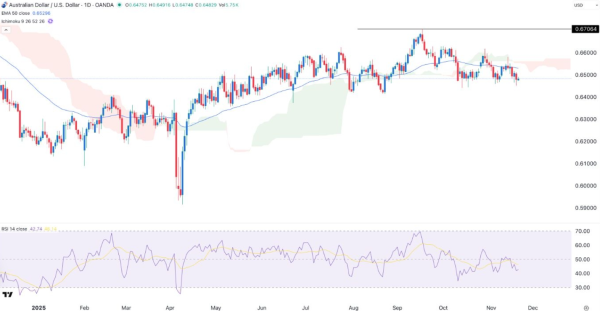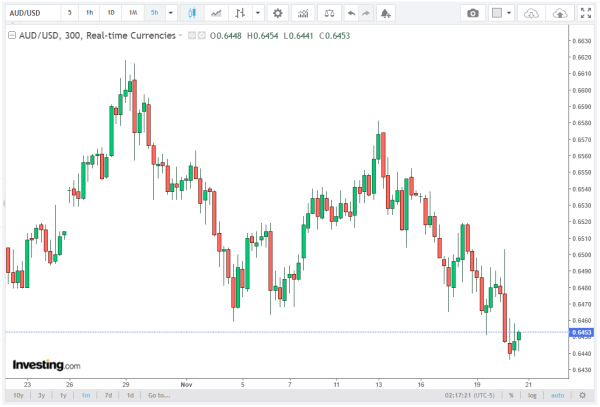The AUD/USD exchange rate is approaching a critical point as the market digests a mix of monetary policy signals, economic data expectations, and shifting risk sentiment. The pair traded around 0.6485, a level it has hovered near for several sessions, indicating a phase of consolidation before a potential volatility spike. This article from Arbitics gives readers a clear and thorough explanation of the subject.
With traders assessing the impact of the latest Federal Reserve meeting minutes and preparing for the upcoming US Nonfarm Payrolls (NFP) release, the currency pair’s next major move could be imminent.
Fed Minutes and US Jobs Report: Fundamental Drivers
The AUD/USD pair has been under steady pressure due to recent developments from both the United States and Australia. On the Australian front, the Reserve Bank of Australia (RBA) released minutes that provided insight into the bank’s stance on upcoming interest rate decisions.
Officials reiterated that future easing would depend heavily on incoming labor market data, signalling that the central bank is not yet ready to commit to further cuts without more evidence of slowing demand. Market analysts broadly expect the first RBA rate cut to occur in the first quarter of next year, adding to the cautious outlook for the Australian dollar.
In the United States, the latest Federal Reserve minutes highlighted persistent concerns about inflation, which remains above the central bank’s 2% target. The minutes revealed a divided committee, with some officials open to further policy tightening if inflation fails to moderate.
This uncertainty has cast doubt on expectations for an imminent Fed rate cut, prompting a broad strengthening of the US dollar across the American and Asian sessions. As a result, the AUD/USD pair has struggled to stage a meaningful recovery.
The next major catalyst is the release of the September US jobs report. Scheduled for later today, this dataset will give traders more clarity on the direction of the American labor market, a crucial determinant of near-term monetary policy.
According to a Reuters poll, economists expect the US economy to have added 50,000 jobs in September, a notable increase from 22,000 in the prior month. These projections come amid a wave of corporate layoff warnings, especially from large retail and technology firms such as Amazon and Target.
Stronger-than-expected employment figures would reinforce the case for a hawkish Federal Reserve, likely pushing the AUD/USD pair lower. Conversely, weaker data could soften the greenback and allow the Australian dollar some breathing room. The outcome will shape expectations around the Fed’s next steps and may determine whether the AUD/USD continues its current downward pattern or attempts a short-term rebound.
AUD/USD Technical Analysis: Bearish Structure Strengthens
On the technical front, the daily chart reveals a currency pair locked within a narrow trading range over recent months. The most notable recent development is the pair’s drop below the 50-day Exponential Moving Average (EMA), a widely watched indicator that typically signals deteriorating bullish momentum when breached.
More importantly, price action has carved out a clear head-and-shoulders pattern, one of the market’s most reliable bearish reversal structures. The pair currently trades only slightly above the neckline, suggesting that a decisive breakdown could be approaching. A confirmed break below this neckline would likely trigger accelerated selling pressure and open the door to a more pronounced decline.
Additional indicators reinforce the bearish tone. The AUD/USD has slipped beneath the Ichimoku cloud, showing that overall trend momentum has shifted toward sellers. At the same time, the Relative Strength Index (RSI) has dipped below the crucial 50 level, signalling weakening buying pressure and a possible continuation of downside momentum.
From a key-levels perspective, the area around 0.6400 stands out as the next major support zone to watch. A move toward this level would confirm the pair’s bearish bias and potentially pave the way for a deeper correction.
On the upside, a break back above the 50-day EMA could provide temporary relief and open the door to a retest of the upper boundary of the range. However, given current fundamentals and technical positioning, such a move would likely encounter heavy resistance.
Conclusion: A Bearish Breakout Looms
The AUD/USD signal is clear: the pair is hovering at a crossroads defined by crucial fundamental catalysts and a deteriorating technical setup. With the Fed maintaining a cautious stance and the US jobs market showing signs of resilience, the US dollar retains a strong footing. Meanwhile, RBA uncertainty and subdued risk appetite continue to weigh on the Australian dollar.
Unless incoming data surprises substantially, the balance of risk appears tilted toward a bearish breakout, with 0.6400 emerging as the next significant target. Traders should monitor price action around the head-and-shoulders neckline and watch for volatility surrounding the NFP report, as these factors will likely determine the pair’s next decisive move.









